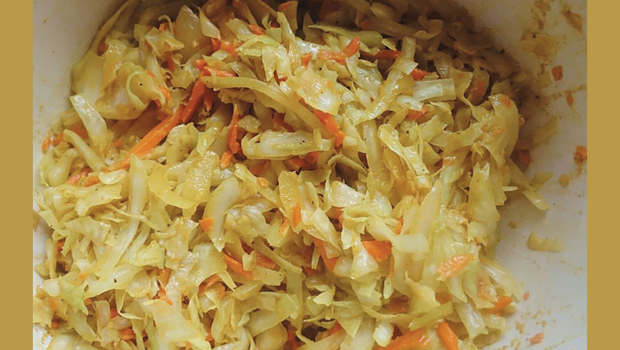Curry Kraut
2 lb organic cabbage head
2 Tbsp sea salt
½ cup organic yellow onion, thinly sliced
½ cup shredded carrot
6 cloves garlic, minced
1 Tbsp fresh, grated ginger (1 Tbsp ground powder alternative)
½ Tbsp ground coriander
½ Tbsp ground cumin
½ tsp ground cayenne pepper
½ tsp ground turmeric
½ tsp curry powder
¼ tsp black pepper
¼ tsp cinnamon
First, rinse all of the produce. Then peel the outer layers off the cabbage, saving a couple of the cabbage leaves.
Cut the cabbage in half (through the core), then in half again, then core the cabbage by placing wedges up vertically on a cutting board with the core touching the board and holding it at the tip. Position the knife at the start of the core and slice downward, cutting off the hard portion.
Place the cabbage on a flat side and slice shreds to desired thickness (about ¼ inch). Start at the tip and work down.
Thinly slice the onion and then shred carrots using a cheese grater.
Place it all into one very large or two non-reactive bowls (not metal). Pour the spices on top. Massage the mixture of veggies and spices until a lot of brine has been created and the mixture has shrunk down to about half its original size.
Take the massaged veggies and spices, and start packing them into a 1-quart fermenting jar with an airtight lid. (The packing will help bring the brine to the surface.) After every scoop that’s put into the jar, pack it down with a fist. Leave several inches at the top of the jar.
Fold up the saved cabbage leaves and put them on top of the cabbage in the jar. (Make sure the brine goes over the top of the cabbage leaves.) Place the weight—either a fermenting weight or rocks inside of a bag—on top of the cabbage leaves. Leave about 1 to 2 inches at the top of the jar.
Close the jar’s lid and put it in some sort of basin (I use a casserole dish) to catch the brine that comes out. The brine will come out of the jar because the cabbage will swell during the fermentation process, and the basin will catch the brine instead of it spilling onto counters.
Notes: Over the next few days, the mixture will turn into curry kraut through a lacto fermentation process. Bubbles and the bright green cabbage will become yellow. How long to wait depends on the level of sourness desired and how warm the house is kept.
Check the curry kraut for taste. It’s good to check after about three to five days to see if it’s sour enough. It’s also good to do a quick check for mold. It’s likely a white, scummy-type substance will form at the top of the brine; this is okay and part of the process. It can be scraped off or left there.
When curry kraut reaches desired taste, take out the cabbage leaves and the weight, close the lid and put it in the fridge.
Make sure to start with a clean surface and utensils. Dirty supplies can mess with the bacteria in the fermentation.
Courtesy of Kyrie Luke, Healthfully Rooted Home.




























